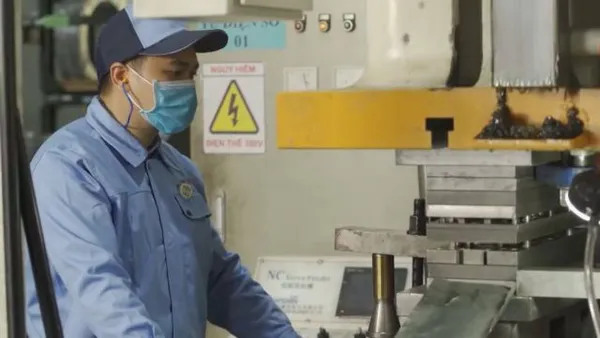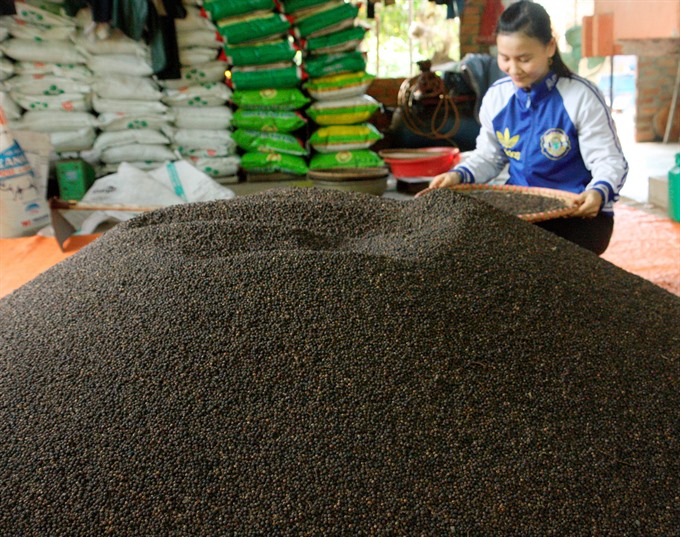 Economy
Economy

The Ministry of Agriculture and Rural Development (MARD) announced recent drops in pepper prices, both domestic and exported, in October.
 |
| A farmer checks the quality of pepper in the southern province of Bình Phước. Pepper prices dropped in both domestic and export markets last month due to an increase in production yields and a fall in world demand. — VNA/VNS Photo Đình Huệ |
HCM CITY — The Ministry of Agriculture and Rural Development (MARD) announced recent drops in pepper prices, both domestic and exported, in October.
The cause for the fall in prices is said to be a sharp increase in quantity.
According to the MARD, the October domestic buying price for black peppers continued to decline, compared to September. On average, buying prices for dried raw black pepper in the main producing regions of Gia Lai, Bà Rịa- Vũng Tàu, Đắk Lắk and Đồng Nai were VNĐ142,900 (US$6.39), VNĐ146,800, VNĐ143,900 and VNĐ143,900 per kilo, respectively, all having decreased by VNĐ4,000 per kg compared to last month’s average price.
Hoàng Phước Bính, General Secretary of the Chư Sê Pepper Association in Gia Lai, said that the current pepper price in the province had dropped to a mere VNĐ125,000 per kg, as compared to the peak prices in the middle of the year of VNĐ170,000 to VNĐ180,000. At this level of the decline in the buying price, farmers can still turn a profit, though less than before.
The export price for pepper had been on the decline this year, in addition to the drop in domestic prices. According to the Việt Nam Pepper Association’s (VPA), in just the first nine months of 2016 the average export price was $7,726 per tonne for black pepper and $11,329 per tonne for white pepper. Compared to the same period last year, these export prices dropped by $1,232 and $1,533 per tonne, respectively.
The reason for such a decline is considered to have been the fall in world demand, while supply rose steeply. Đỗ Hà Nam, VPA’s president, said that the rise in the pepper supply was due to the fast expansion of growing areas in recent years, from 50,000 hectare to 101,000 hectare, being more than twice the planned number from 2020 to 2030, as decided by the MARD.
“With the production cost similar to coffee, and a price three times higher, farmers would undoubtedly mass produce pepper, leading to the current unplanned situation. If this continues, there is bound to be an excess surplus crisis in the pepper industry, as have been with other plants,” said Nam.
With its constant development in recent years, the Vietnamese pepper industry is facing many challenged regarding quality and quantity controls. If these problems are not resolved, the country’s export status could be overtaken by other producers, and the benefits from signed trade agreements would not be utilised.
Nam also warned that should farmers and businesses continue to produce at the current rate and on the current scale, in lieu of the excessive quantity, the price of peppers would drop even further. He suggested that producers switch to a different crops that offer greater economic value.
An excess in imports could also be the reason of the recent fall in pepper price. According to the VPA, several markets, such as Australia, Germany, Singapore and others, have gradually reduced the quantity imported, while potential European markets have come to a halt. This could be due to both the lack of dealers and the lack of quality in Vietnamese exports.
VPA suggested that the key solution to the quality problem would be to improve the raw ingredients used on the field.
If the quality of pepper exports is not improved in the near future, the amount exported will surely decline, as more countries are tightening their supervision on imported peppers, such as in the US market where the Food and Drug Administration (FDA) is about to implement several new regulations regarding imported agricultural products, including Vietnamese peppers.
Việt Nam is currently the largest global supplier for peppers, with more than 50 per cent of total world products. With such an overwhelming supply, the inelastic demand, once halted, would cause Vietnamese farmers and businesses to lose money. — VNS